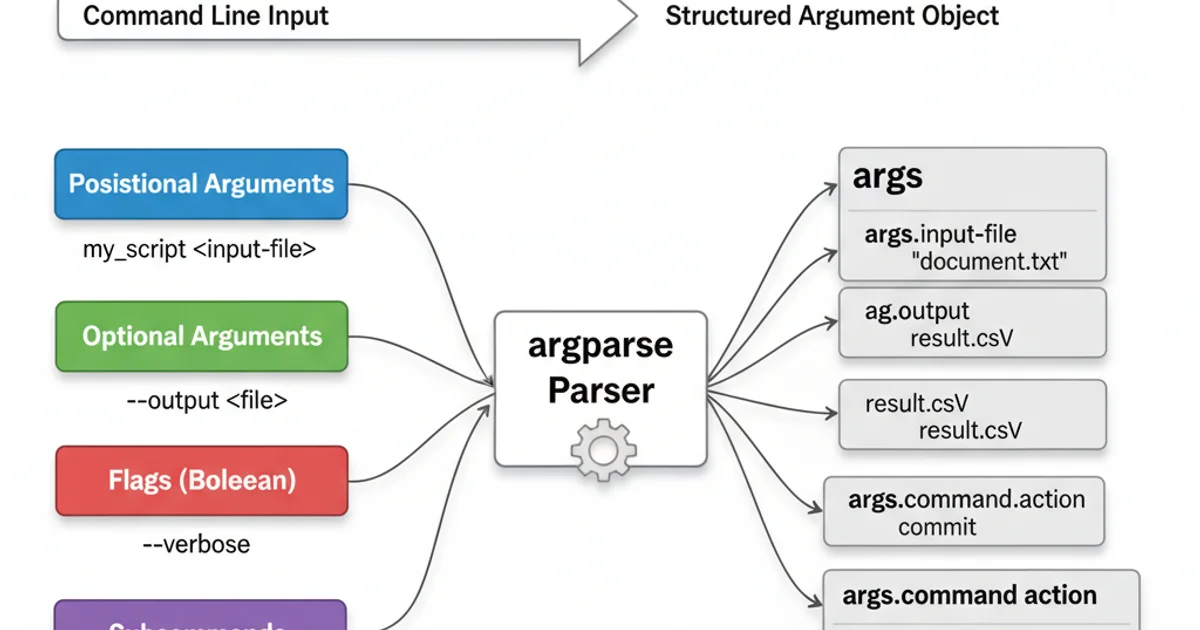What's the best way to parse command line arguments?
Categories:
Mastering Command Line Arguments in Python

Explore the best practices and tools for parsing command-line arguments in Python, from basic sys.argv to advanced argparse.
Command-line arguments are a fundamental way to interact with scripts and programs, allowing users to customize behavior without modifying source code. In Python, there are several approaches to handling these arguments, each with its own advantages and use cases. This article will guide you through the most common and effective methods, helping you choose the right tool for your project.
The Basics: sys.argv
The simplest way to access command-line arguments in Python is through the sys module. The sys.argv list contains all command-line arguments, where sys.argv[0] is the script name itself, and subsequent elements are the arguments passed by the user. This method is straightforward for very simple scripts but quickly becomes cumbersome for more complex argument structures.
import sys
print(f"Script name: {sys.argv[0]}")
if len(sys.argv) > 1:
print(f"Arguments: {sys.argv[1:]}")
else:
print("No arguments provided.")
Basic argument parsing using sys.argv.
sys.argv is easy to use, it provides no built-in help messages, type conversion, or error handling. You'll need to implement these features manually, which can lead to verbose and error-prone code for anything beyond the most trivial cases.The Standard: argparse Module
For robust and user-friendly command-line interfaces, Python's built-in argparse module is the de facto standard. It handles parsing, type conversion, default values, help message generation, and error reporting automatically. argparse allows you to define expected arguments, whether they are positional or optional, and provides a structured way to access their values.
flowchart TD
A[Start Script] --> B{Define Parser}
B --> C[Add Arguments (e.g., --file, -v, <input>)]
C --> D[Parse `sys.argv`]
D --> E{Arguments Valid?}
E -- Yes --> F[Access Argument Values]
E -- No --> G[Display Error/Help]
F --> H[Execute Logic]
H --> I[End Script]Workflow for parsing command-line arguments using argparse.
import argparse
def main():
parser = argparse.ArgumentParser(description="A simple script to demonstrate argparse.")
# Positional argument
parser.add_argument("input_file", help="The path to the input file.")
# Optional argument with a default value
parser.add_argument("--output", "-o",
default="output.txt",
help="Specify the output file name (default: output.txt).")
# Boolean flag
parser.add_argument("--verbose", "-v",
action="store_true",
help="Enable verbose output.")
args = parser.parse_args()
print(f"Input file: {args.input_file}")
print(f"Output file: {args.output}")
if args.verbose:
print("Verbose mode enabled.")
else:
print("Verbose mode disabled.")
if __name__ == "__main__":
main()
Example of using argparse to define and parse arguments.
argparse, users can automatically get a help message by running your script with --help or -h. This is a significant advantage for usability and maintainability.Advanced argparse Features
argparse offers a rich set of features for more complex scenarios, including subcommands, argument groups, custom types, and mutually exclusive arguments. These features allow you to build sophisticated command-line tools with clear and intuitive interfaces.

Conceptual overview of argparse capabilities.
import argparse
parser = argparse.ArgumentParser(description="A program with subcommands.")
subparsers = parser.add_subparsers(dest="command", help="Available commands")
# Create the parser for the "add" command
add_parser = subparsers.add_parser("add", help="Add two numbers")
add_parser.add_argument("num1", type=int, help="First number")
add_parser.add_argument("num2", type=int, help="Second number")
# Create the parser for the "subtract" command
subtract_parser = subparsers.add_parser("subtract", help="Subtract two numbers")
subtract_parser.add_argument("num1", type=int, help="First number")
subtract_parser.add_argument("num2", type=int, help="Second number")
args = parser.parse_args()
if args.command == "add":
print(f"Result: {args.num1 + args.num2}")
elif args.command == "subtract":
print(f"Result: {args.num1 - args.num2}")
else:
parser.print_help()
Using argparse with subcommands for different operations.
argparse is powerful, avoid over-complicating your CLI. A well-designed CLI is intuitive and easy to use. If your argument structure becomes too complex, consider breaking your tool into smaller, more focused scripts.